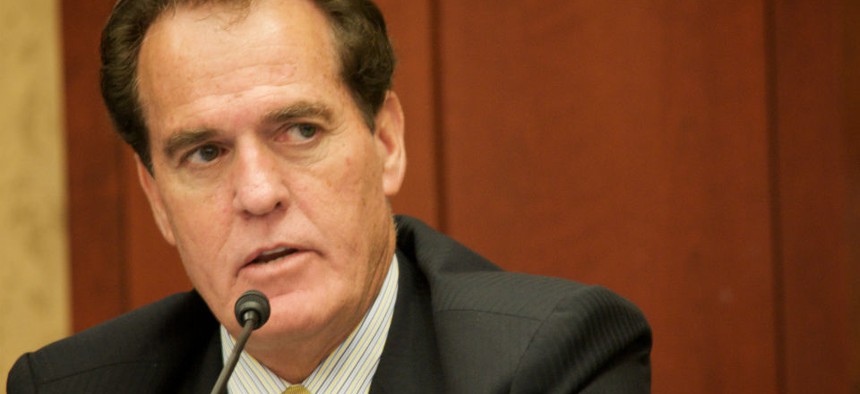
Rep. Phil Gingrey, R-Ga., was one of the lawmakers interested in data on use of official time. Flickr user House GOP
The Time Feds Spend on Union Biz Inches Up
Federal employees spent 3.43 million hours on “official time” in fiscal 2012, according to the latest report.
This story has been updated.
Federal employees spent slightly more time at work on union activities in fiscal 2012 than they did in fiscal 2011, according to a new report from the Office of Personnel Management.
The overall increase – 1.3 percent – was negligible: Feds spent 3.43 million hours of “official time” on union business across government in fiscal 2012, compared to 3.39 million hours in fiscal 2011. The amount the government spent on average for those employees’ taxpayer-funded salaries inched up from $155.6 million in fiscal 2011 to $157.2 million in fiscal 2012. The number of official time hours used per bargaining unit employee on union matters during fiscal 2012, however, decreased slightly from fiscal 2011, falling from 2.82 hours to 2.81 hours.
Still, the extra time and money devoted to union activities is growing, if slightly. The cost of official time used by federal employees participating in union activities increased nearly 7 percent between fiscal 2008 and fiscal 2009; OPM found that federal employees spent nearly 3 million hours of official time on union activities in 2009 at a cost of $129 million to taxpayers, an increase of $8 million from fiscal 2008.
Individual increases and decreases in official time among the 62 agencies included in OPM’s October 2014 report, however, varied widely. For instance, the Export-Import Bank experienced an 81.7 percent drop in official time hours between fiscal 2012 and 2011; at the other end of the spectrum, the time that Smithsonian employees spent on official time spiked 2,005 percent between fiscal 2011 and fiscal 2012 – from 77.75 hours to 1,637 hours. Twenty-nine of the 62 agencies reported reductions in the number of official times hours used.
The Veterans Affairs Department reported the most total hours spent on official time in fiscal 2012 – 1.1 million hours – followed by the Treasury Department with 580,490 hours. The National Labor Relations Board reported the most hours per bargaining unit employee (11.73) in fiscal 2012. Unions represent sixty percent of the non-postal federal workforce; at VA, two-thirds of the workforce belongs to a union.
The 1978 Civil Service Reform Act requires federal employee unions to provide representation for all employees in their collective bargaining units, even those who do not pay union dues; as part of that arrangement the law allows union representatives and agencies to bargain during official work hours. Legal activities include participating in labor-management workshops, negotiating contracts and other collective bargaining agreements, and representing employees in grievances and disciplinary actions. Employees cannot use official time for internal union business, including solicitation of new members or partisan political activity. In 2009, President Obama issued an executive order to encourage and promote labor-management partnerships to improve government efficiency, establishing the national council on federal labor-management relations.
The American Federation of Government Employees defended the use of official time as a way for employees and management to work on problems more efficiently, and also provide a safe environment for whistleblowers. "Official time is less expensive for taxpayers in the long run because it helps resolve conflicts that arise in the workplace without resorting to expensive and time-consuming administrative or legal procedures," said AFGE President J.David Cox Sr., in a statement. "In fact, the cost of official time was just 1/10 of one-percent of the total cost of salary and benefits for federal employees in fiscal 2012 – hardly the boondoggle anti-union politicians and pundits say."
Republican lawmakers in recent years have criticized the amount of time federal employees spend on union activities on the taxpayer’s dime. Rep. Dennis Ross, R-Fla., introduced a bill in 2013 calling for OPM to submit an annual report to Congress on the use of official time. Congress last required OPM to report on official time in 1998, and the agency began doing so voluntarily in 2002. However, in the last few years, reporting has been inconsistent and the latest data before OPM released its report this month was for fiscal 2011.
In March, Ross and Rep. Phil Gingrey, R-Ga., sent a letter to OPM Director Katherine Archuleta asking for a report on fiscal 2012 official time data in April. “Given that this information should be readily available – as agencies are supposed to document the use of official time – we feel confident that the continued production of the official time report should be possible and that its release will be expedient,” the lawmakers wrote at the time.
OPM pitched its latest report as a more comprehensive look at labor-management relations in government today. “Recognizing that many of the benefits achieved through improved labor-management relations can be difficult to quantify, we hope to tell a more complete story than previously reported,” the agency said in the summary.
(Image via Flickr user House GOP)
NEXT STORY: VA Employees Fight for More Pay







